Farriers: No hoof, no horse
Dr. Kimberly Brokaw
Walkersville Veterinary Clinic
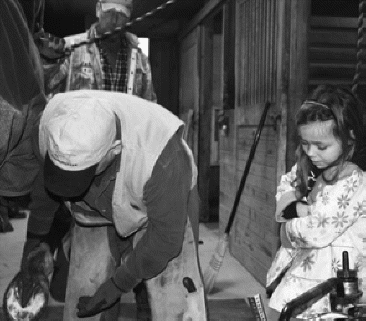 (1/2012) A good farrier is worth his or her weight in gold. A bad farrier can drive the owners crazy and can permanently cripple a horse. Despite the
critical importance of farriers to the well being of horses, in the U.S. farriers are not required to go to school to learn how to shoe a horse. While there are schools that teach horse shoeing, the schools greatly differ in
content and quality. A few schools offer a simple weekend class before declaring their students competent to shoe horses. Other programs require years of training and supervision. Farriers are not required to pass a national
licensing exam in the US, or even to get a state license. This obviously leads to vastly different skill levels among farriers.
(1/2012) A good farrier is worth his or her weight in gold. A bad farrier can drive the owners crazy and can permanently cripple a horse. Despite the
critical importance of farriers to the well being of horses, in the U.S. farriers are not required to go to school to learn how to shoe a horse. While there are schools that teach horse shoeing, the schools greatly differ in
content and quality. A few schools offer a simple weekend class before declaring their students competent to shoe horses. Other programs require years of training and supervision. Farriers are not required to pass a national
licensing exam in the US, or even to get a state license. This obviously leads to vastly different skill levels among farriers.
Years of school leaves an equine veterinarian knowing how he or she wants a horse shod, yet without the strength and knowledge to shoe a horse. Very few veterinarians possess the skills to actually shoe a
horse. This allows for the creation of an environment where vets and farriers are frequently at odds with each other. One has the theoretical knowledge of how to shoe a horse and the other has the skill to actually do it. I am
reminded of an encounter several years ago when my farrier was working on another veterinarian’s horse. The vet kept telling him how to shoe the horse. "No take a little more off the heel. Now the toe. Put a wedge on the shoe.
No not that much." That went on until my farrier turned on the other vet, threw his equipment at him and said "You do it. I’m leaving" and got in his truck and drove off. Luckily he returned later and finished the job as the vet
had never shaped a shoe or nailed one to a horse. The health of the poor horse would have been at risk if the veterinarian had tried to put shoes on the horse without appropriate farrier supervision.
Because veterinarians usually don't do shoeing, they often have unrealistic expectations of what a farrier can accomplish when given a horse with neglected feet. Farriers often have little respect for the
skills of veterinarians, as it is hard to respect someone who "consults" about a job that they cannot actually perform. Veterinarians are sometimes reluctant to listen to farrier opinions because farriers lack formal education
and licensure. This often leads to conflict between veterinarians and farriers, with the owner and the horse left to sort out the battles.
When I decided to write about the topic of farriers, one of my bosses asked me not to write the article. He asked me if I really wanted to alienate any more farriers than I already had. (That comment
related to my first 6 months in Maryland almost 4 years ago when I went through a new, supposedly good farrier every 5 weeks/shoe cycle before declaring them all incompetent and
driving my horses down to Virginia to get shod (the same place Mike Hillman, the editor of this paper
gets his horse shod at!) I have since found a farrier who has come to my house for the past few years and does a great job.) While at first I thought I would take my bosses advice, I was speaking with Mike over a chili
dinner when he declared that I should write my next article about shoeing horses.
I politely pointed out to him that farriers tend to be big strong burly guys and, as I was not, perhaps I didn’t want to further irritate them by publishing an article in which I critique their work. Mike
laughed, told me to make it educational, and write to the article. He also asked me to take pictures of horse hooves to include in the article to illustrate both good and bad farrier work. As this was decided only 10 days before
my article was due, I was nervous that I wouldn’t be able to find a picture of really bad farrier work in time for the article. My fears were unfounded as the next day I was at a farm when an opportunity to take a picture of bad
farrier work presented itself.
Within the veterinary community and the farrier community, there is little agreement on what constitutes a perfect shoeing. There is agreement about what constitutes an abyssmally bad shoeing. The idea of
a good basic shoeing is to trim the hoof so the angle of the hoof approximates the angle of the horses' pastern. The toe of the foot often needs more trimming than the heel to get that ankle. The shoe needs to be big enough so
there is room for the heels to grow and still have shoe under them. The amount of room can be difficult to determine for each horse. If the farrier does a beautiful job, but the horse catches his hind foot on the end of the
front shoe, that beautiful new shoe will be ripped off. Balancing the foot is also important.
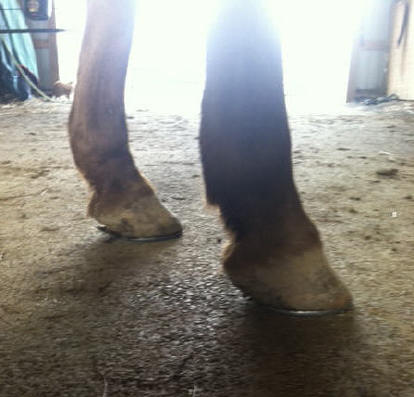 The foot in picture above to the right is poorly shod. The heels are underrun/collapsed and completely lacking in support as well as being too
tall and in need of a trim. By using too small of a shoe, greater stresses were applied on the heel making them prone to collapse. By keeping the heel elevated, the coffin joint was forced into flexion. The shoe was too small
for the foot, the toe hadn’t been shortened enough and the right foot was trimmed to a completely different shape than the left foot. While the right foot has a fairly upright and short toe, the left’s toe is too long creating
strain on the flexor tendons and suspensory ligament. Not surprisingly this horse is lame despite being fairly young and hardly ridden. While the blame for this poor shoeing could be related to an owner leaving shoes on for too
long, in this case the horse had been shod less than a week ago. Most horses need new shoes at 5 or 6 week intervals. A farrier cannot be blamed for "bad shoeing" if the owner only has him come out every 3 months.
The foot in picture above to the right is poorly shod. The heels are underrun/collapsed and completely lacking in support as well as being too
tall and in need of a trim. By using too small of a shoe, greater stresses were applied on the heel making them prone to collapse. By keeping the heel elevated, the coffin joint was forced into flexion. The shoe was too small
for the foot, the toe hadn’t been shortened enough and the right foot was trimmed to a completely different shape than the left foot. While the right foot has a fairly upright and short toe, the left’s toe is too long creating
strain on the flexor tendons and suspensory ligament. Not surprisingly this horse is lame despite being fairly young and hardly ridden. While the blame for this poor shoeing could be related to an owner leaving shoes on for too
long, in this case the horse had been shod less than a week ago. Most horses need new shoes at 5 or 6 week intervals. A farrier cannot be blamed for "bad shoeing" if the owner only has him come out every 3 months.
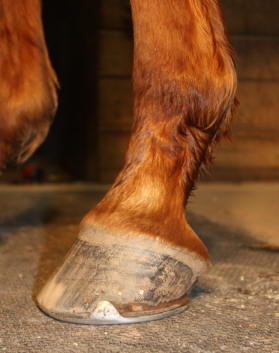 The ideal trim and shoe job should look like the second picture (done by the exceptionally good farrier at the Virginia Tech in Leasburg). Traits
that make this an example of good shoeing are that when viewed from the side, the front hoof wall is parallel to the front surface of the pastern. The angle of the heel is also about the same as that of the front hoof wall. The
length of the heel is about one third the length of the toe. When viewed from the sole/ground surface the length and the width of the front hoof capsule are the same. The sole is concave and the frog width is at least 50-67% the
frog length. The weight bearing surface of the heels coincides with the widest part of the frog. When viewed from the front a line drawn across the coronary band is parallel to the ground and perpendicular to the axis of the
leg/ metacarpal region. Not only does this horse demonstrate good shoeing he only has mild arthritis despite being older and possessing an extensive competition history.
The ideal trim and shoe job should look like the second picture (done by the exceptionally good farrier at the Virginia Tech in Leasburg). Traits
that make this an example of good shoeing are that when viewed from the side, the front hoof wall is parallel to the front surface of the pastern. The angle of the heel is also about the same as that of the front hoof wall. The
length of the heel is about one third the length of the toe. When viewed from the sole/ground surface the length and the width of the front hoof capsule are the same. The sole is concave and the frog width is at least 50-67% the
frog length. The weight bearing surface of the heels coincides with the widest part of the frog. When viewed from the front a line drawn across the coronary band is parallel to the ground and perpendicular to the axis of the
leg/ metacarpal region. Not only does this horse demonstrate good shoeing he only has mild arthritis despite being older and possessing an extensive competition history.
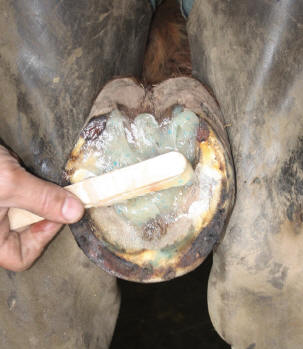 Therapeutic or corrective shoeing is essential for some horses to maintain soundness. There are many different types and styles of shoe, all with different purposes. These shoes come in an array of shapes (eggbar, heartbar, wedge, etc) as well as material (steel, aluminum, wood) that can be
used. Not only can the shoe be altered but additional material can also be added. Pads of varying materials and thicknesses can also be used to increase the comfort of a horse.
Therapeutic or corrective shoeing is essential for some horses to maintain soundness. There are many different types and styles of shoe, all with different purposes. These shoes come in an array of shapes (eggbar, heartbar, wedge, etc) as well as material (steel, aluminum, wood) that can be
used. Not only can the shoe be altered but additional material can also be added. Pads of varying materials and thicknesses can also be used to increase the comfort of a horse.
The third and fourth picture show different stage of applying corrective shoes. This horse is a skilled eventer. He also has thin soles and hoof walls. Those traits make him more likely to bruise, get hoof cracks, and otherwise be lame. In fact prior to receiving therapeutic shoeing, this horse was lame. The pictures shown were taken after the foot had
been trimmed and balanced. The farrier has then applied a silicone base to the pad and shoe. The combination of shoe and two layers of padding serve to provide some sole support and protection. This is just one of many different types of manipulations that can be done for a horse.
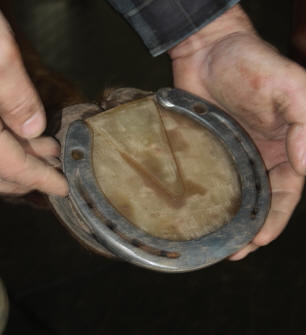 What may seem like miniscule deviations from "normal" trimming and shoeing can result in the long-term soundness of a horse that would otherwise be lame. There are numerous diseases such as laminitis,
navicular, ringbone, and other osteoarthropathies that can benefit tremendously from minute changes in farrier work. When discussing diseases such as navicular with my clients, in addition to injecting steroids, HA, IRAP, or
other therapeutics into the joint or bursa, I always discuss the importance of having a good farrier who can provide the appropriate corrective shoeing. Now if you are fortunate enough to have a farrier who is not only skilled
but also shows up when he says he will and returns your phone calls then you truly do have one that is worth his weight in gold.
What may seem like miniscule deviations from "normal" trimming and shoeing can result in the long-term soundness of a horse that would otherwise be lame. There are numerous diseases such as laminitis,
navicular, ringbone, and other osteoarthropathies that can benefit tremendously from minute changes in farrier work. When discussing diseases such as navicular with my clients, in addition to injecting steroids, HA, IRAP, or
other therapeutics into the joint or bursa, I always discuss the importance of having a good farrier who can provide the appropriate corrective shoeing. Now if you are fortunate enough to have a farrier who is not only skilled
but also shows up when he says he will and returns your phone calls then you truly do have one that is worth his weight in gold.
What is your role as the owner in keeping your horse well shod? Your most important job is making sure your horse is seen by the farrier at regular intervals. Some horses need to be seen every 4 weeks, others every 6 or 7 weeks. If you forget to schedule appointments or procrastinate in order to save money, you can't blame the farrier for less than
perfect work. Another important role is making sure your horse will behave for the farrier. A petulant, disobedient horse who repeatedly yanks his leg away from the farrier will probably not get as good of a job as a cooperative horse. It is the owner's job to train the horse.
Once you find a good farrier, treat him well. Make sure you pay him promptly and that you make his working conditions as tolerable as possible. When it is 25 degrees and windy, it is easier to work inside a barn with the barn doors closed, instead of out in the open. Once you have found that farrier who is worth his weight in gold, you don't want to lose him.
Read other articles by Dr. Kim Brokaw